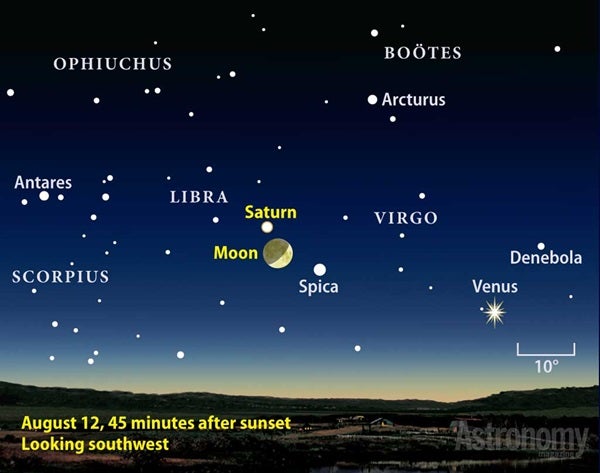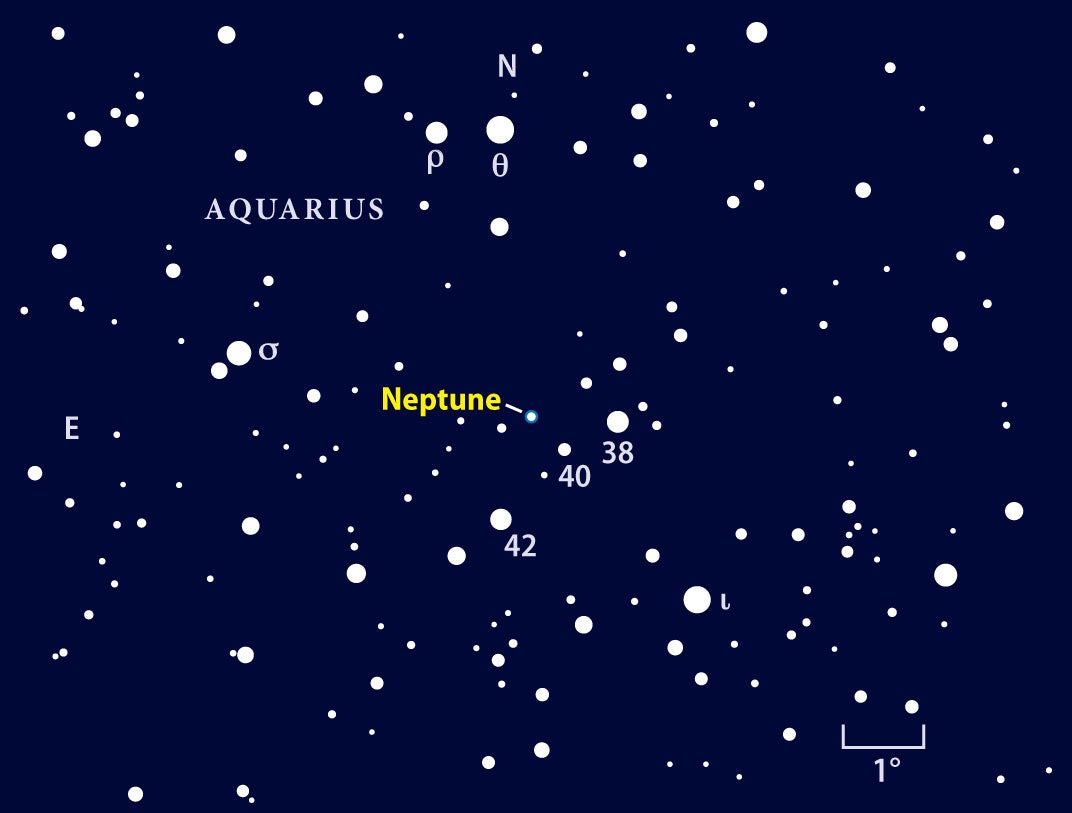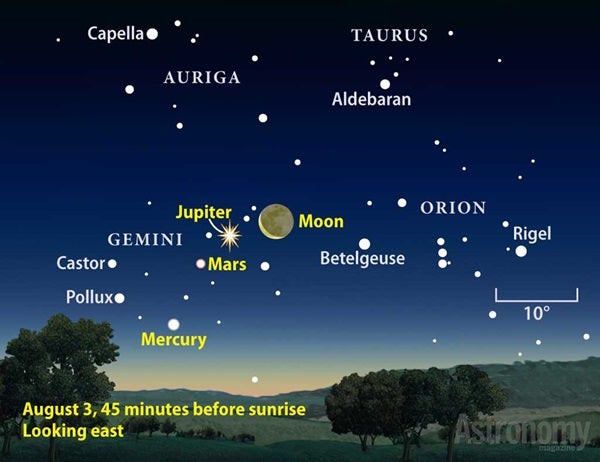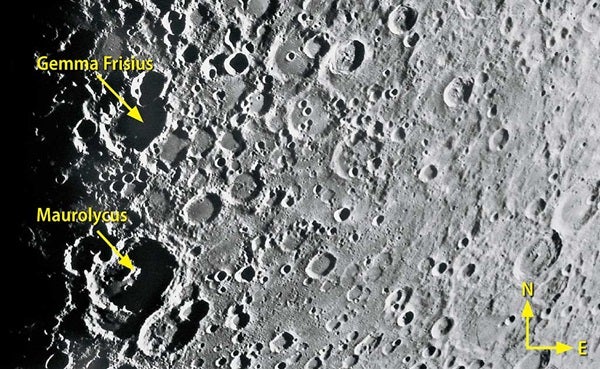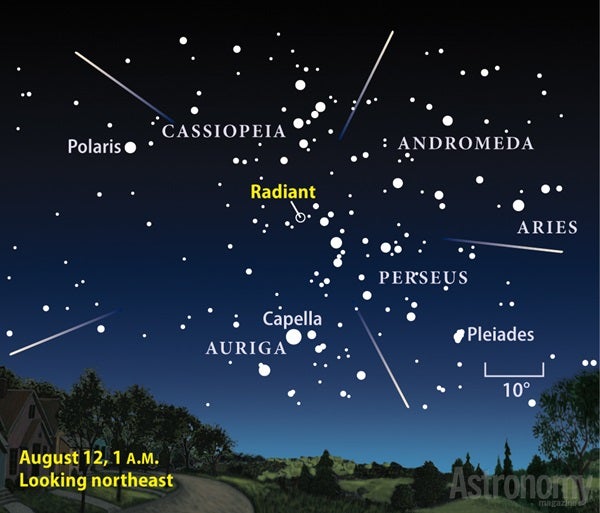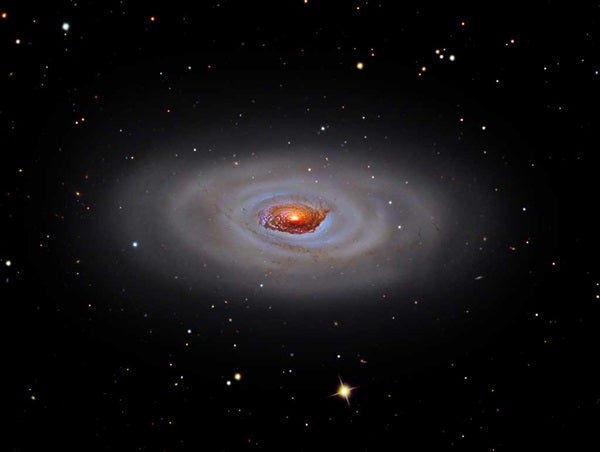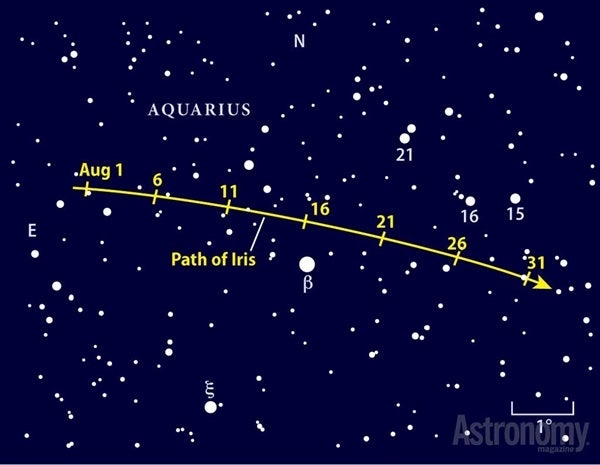The only planetary denizens of the midnight hour are the distant ice giants, Uranus and Neptune. The latter of these worlds will be a prime target late this month when it reaches opposition and peak visibility. But August’s top attraction likely will be the year’s best meteor shower, the Perseids, which peaks under Moon-free skies before dawn August 12.
We’ll begin our tour of the night sky while twilight still brightens the western horizon. Despite this glow, Venus sticks out like a sore thumb because it shines brilliantly at magnitude –3.9. No other celestial point of light rivals it. The planet remains visible throughout August at essentially the same altitude. If you view from mid-northern latitudes a half-hour after sunset, it hovers about 10° high all month.
On August 9, a thin crescent Moon passes 5° south (to the lower left) of Venus. Set against the colorful twilight glow, the pair will look spectacular with naked eyes or binoculars and will make a fine photographic subject. Add elegance to your images by placing a distinctive foreground feature in silhouette. The three-day-old Moon appears 10 percent lit that evening; through a telescope, Venus shows an 80-percent-lit phase on a 13″-diameter disk.
On August 10, the Moon crosses from Leo the Lion into Virgo the Maiden. Venus makes the same leap the following night, by which time the Moon (now 25 percent lit) lies near Virgo’s brightest star, 1st-magnitude Spica.
Virgo harbors one other planet these August evenings, and it’s a beauty. Saturn resides at the large constellation’s eastern end, which places it significantly higher than Venus in the evening sky. On the 1st, it stands 20° above the southwestern horizon at the end of twilight. By the 31st, it appears half that high.
When the waxing crescent Moon passes through Virgo before midmonth, it helps create an attractive scene August 12. That evening, the 35-percent-lit Moon forms a triangle with Saturn and Spica. Our satellite appears 5° below the ringed planet and 8° to Spica’s upper left. At magnitude 0.7, Saturn shines almost imperceptibly brighter than Spica.
Although Saturn looks pleasant enough with naked eyes and binoculars, it doesn’t truly shine until you view it through a telescope. That’s the only way you can see the gorgeous rings, which span 38″ in early August and tilt 17° to our line of sight.
Even the smallest scope will show the rings. With a bit of care, you should see Saturn’s shadow obscuring a small section of the rings behind and just east of the planet’s disk. Although the shadow extended farthest from the planet and concealed the biggest part of the rings in late July, the view in early August is nearly as good. It gives the ringed world a striking 3-D appearance.
Tethys, Dione, and Rhea all glow at 10th magnitude and lie closer to Saturn than Titan. A similarly bright moon, Iapetus, appears well west of the planet. It reaches greatest western elongation August 17, when it shows up clearly through small scopes because its brighter hemisphere then faces Earth.
Neptune lies opposite the Sun in our sky the night of August 26/27. Opposition marks the peak of an outer planet’s observing season because it then shines brightest (magnitude 7.8), appears largest through a telescope (2.4″ across), and remains on view all night. For a distant world like Neptune, however, the view doesn’t deteriorate much even a couple of months on either side of opposition.
Neptune lies in the sparsely populated constellation Aquarius. On August 1, the ice giant resides 1.1° due west of magnitude 4.8 Sigma (σ) Aquarii. The planet’s westward motion relative to the starry background carries it 1.8° from the star by the 31st. You can see Neptune through binoculars if you hold them steady (or use a tripod); you’ll need a telescope and moderate magnification to discern its blue-gray disk. The best time to look is when it’s high in the south from around midnight to 4 a.m. local daylight time.
Neptune’s sister planet, Uranus, trails about two hours behind its neighbor. Uranus shines at magnitude 5.8 and makes an easy target through binoculars among the dim background stars of southern Pisces. The planet lies 3.6° south of magnitude 4.4 Delta (δ) Piscium. A telescope reveals Uranus’ 3.6″-diameter disk and blue-green color. For more details about observing Uranus, Neptune, and their moons from August through October, see “Prime time for Neptune and Uranus” on p. 80.
On August 3, the Moon lies 7° to Jupiter’s right. The following morning, our satellite appears 5° to the lower right of Mars, and it passes 5° to Mercury’s lower right the day after that (August 5). The Moon returns to Jupiter’s vicinity August 31.
The brightest of the morning planets is Jupiter, which shines at magnitude –2.0 in mid-August. The giant world lies among the background stars of Gemini and climbs higher with each passing day. By the 31st, it rises around 2 a.m. local daylight time. The observing season for Jupiter is getting underway, and views of the planet through a telescope should be exquisite. In moments of steady seeing, subtle atmospheric features come into view on the world’s 34″-diameter disk.
Mars appears only 5° from Jupiter in early August, but the gap grows to nearly 20° by month’s end. The magnitude 1.6 Red Planet crosses from Gemini into Cancer during August’s final week and ends the month 5° west of the Beehive star cluster (M44). A telescope shows little, if any, detail on Mars’ disk, which measures just 4″ across.
For northern observers, the period from late July to early August is one of the best to view Mercury this year. On August 1, the innermost planet stands 10° high in the east-northeast 30 minutes before the Sun rises. It shines at magnitude –0.1 and grows brighter with each new morning. By the 9th, it reaches magnitude –1.0 and should be just as easy to spot despite appearing a couple of degrees lower in the twilight. When viewed through a telescope during this period, Mercury’s disk shrinks from 7″ to 6″ while its phase waxes from 44 percent to nearly 75 percent lit.
The waxing Moon slinks low across the southern sky on summer evenings. Our celestial companion takes on shades of pale yellow through orange because its light takes a longer path through Earth’s atmosphere. To observers south of the equator, however, Luna rides high and shines white during August.
After sunset August 12, the waxing crescent appears in the southwest below Saturn. Turn your telescope on the Moon’s disk, and soak in the breathtaking series of maria in the north before scanning southward across the craters arrayed along the terminator that separates lunar day from night.
Maurolycus, a crater named after a 16th-century Italian mathematician who disagreed with Copernicus’ Sun-centered solar system, sits in the southern third of the disk. The impact that carved out this 70-mile-wide beauty occurred on a relatively thin part of the lunar crust. The blow fractured the crust, creating pathways for lava to seep up and smoothly pave the floor around a complex of central peaks. The impact wiped out half of a crater that lies immediately south of Maurolycus and another one to the northwest.
As the lunar bombardment continued, newer impacts broke up and softened older features. The small craterlets on Maurolycus’ floor are the freshest, but can you figure out the sequence of impacts that created the group on the crater’s northwestern edge? Although the picture above helps, your own observations on the 12th and following evenings are the best way to get the time line straight. A similar story plays out on the crater group anchored by Gemma Frisius a short hop to the north.
As Full Moon approaches, you should see a ray from the distant crater Tycho crossing Maurolycus. Use high magnification to spot this subtle stripe.
The Perseid meteor shower will be at its best before dawn August 12. Not only does this year’s top shower produce lots of meteors — up to 100 per hour under optimal conditions — but it also reaches its peak with the Moon out of the sky. From mid-northern latitudes, the waxing crescent sets shortly after 10 p.m. local daylight time the previous evening.
If predictions hold, the highest rates should be on display from eastern Europe and northern Asia. Although observers in North America might see “only” 80 meteors per hour under a dark sky on the 12th, rates on the following morning could be nearly as high. Wherever you view from, the hour or so before dawn should deliver the best views.
| WHEN TO VIEW THE PLANETS |
||
| Evening Sky |
Midnight | Morning Sky |
| Venus (west) |
Uranus (east) |
Mercury (east) |
| Saturn (southwest) |
Neptune (southeast) |
Mars (east) |
| Neptune (east) |
Jupiter (east) |
|
| Uranus (southwest) |
||
| Neptune (southwest) |
||
Comet ISON (C/2012 S1) has the potential to be one of the best — if not the best — comets during our lives. Even experienced amateur astronomers will be challenged to see every nuance ISON offers. An exceptionally bright comet typically has subtle features near its core and a gas tail that contains strands and kinks caused by the interaction between ionized molecules in the tail and the charged particles of the solar wind.
If you are new to the hobby, now is the time to train yourself to detect these features. Practice also should be the mantra for knowledgeable observers. Even the most experienced ones have trouble discerning delicate details after three months of cloudy skies or when their busy lives get in the way.
With ISON currently glowing at around 12th magnitude in morning twilight, however, the comet isn’t the best object for honing your skills. An ideal practice target lies in the early evening sky. The Blackeye Galaxy (M64) is a spiral with subtlety to spare. A newbie will need an 8- to 10-inch telescope to clearly see the dark patch that gives the galaxy its name; experienced observers should view with a 4- to 6-inch instrument to reawaken dormant skills.
Is the dark patch round? The eyepiece view should show you that it isn’t. If ISON mimics comets Hyakutake (C/1996 B2) and Hale-Bopp (C/1995 O1), it will show a similar-looking shadow cast by the nucleus onto the surrounding ball of gas and dust called the coma.
Also, which edge of M64’s dark patch looks more diffuse, and which one is sharper? Use a range of magnifications, up to the maximum that seeing conditions allow, to make these small features easier to spot. Sketching the scene also helps train your eye to see detail.
For viewing features in Comet ISON’s tail, observe the Veil Nebula in Cygnus. Although the bands of light in this supernova remnant appear brighter at low power, you will need higher magnifications and time at the eyepiece to pick out structure within the swaths of nebulosity.
To gauge how far Comet ISON’s tail extends, practice on the emission nebula NGC 7822 in Cepheus. You’ll need low power to trace the extent of this long, low-contrast stretch of interstellar gas. You’ll get a better view by covering your head with a dark cloth to keep out any stray light. Keep at these techniques, and you’ll be ready for ISON this autumn.
The brightest asteroid to reach opposition in 2013 is not, as it usually is, one of the “Big Four” discovered in the 19th century’s first decade. Instead, 7 Iris is this year’s winner — it glows at magnitude 7.9 when it lies opposite the Sun in our sky August 16. Englishman John Hind discovered this asteroid in 1847 and named it after the Greek goddess of the rainbow.
Iris spends the month in western Aquarius, southwest of the prominent Great Square of Pegasus. This region lies one-third of the way from the southeastern horizon to the zenith in mid-evening and reaches its peak halfway up in the southern sky around 1 a.m. local daylight time.
Your best guide to finding Iris is the 3rd-magnitude star Beta (β) Aquarii. On August 16 and 17, Iris lies just 40′ — a bit more than the Full Moon’s diameter — north of Beta. There won’t be anything else at that position rivaling the minor planet’s 8th-magnitude glow.
The Full Moon passes through this area August 19 and 20, so try to catch Iris before then. The easiest way to find it is to match the stars in your telescope’s field of view with those on the chart below. If a similarly bright background star makes it hard to identify the asteroid, make a quick sketch of the field and come back a night or two later. The dot that moved is Iris.
Martin Ratcliffe provides planetarium development for Sky-Skan, Inc. from his home in Wichita, Kansas. Meteorologist Alister Ling works for Environment Canada in Edmonton, Alberta.


